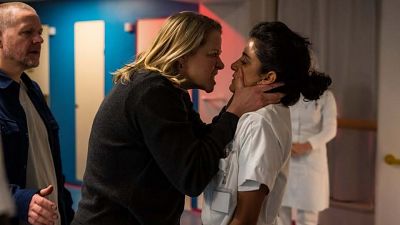
Second Victims - Scandinavian Film Festival
Click here if you liked this article 8 ![]()
https://scandinavianfilmfestival.com
Date Reviewed: 08/07/2025
In Second Victims (2025), Danish director Zinnini Elkington plunges us into the fluorescent corridors of a hospital not with solemn greys and sterile silence, but with jarring colour, fast music, and a disquieting pulse. The film begins almost deceptively, circles within circles spin across the screen like MRI scans or ominous pupils. An eye is watching. The hospital is alive. Or pretending to be.
The title refers to a psychological syndrome, the "second victims" being healthcare professionals left psychologically scarred in the wake of medical tragedy. In this case, that victim is Alexandra (a tightly-wound, quietly blistering performance from Özlem Saglanmak), a neurologist whose assured composure cracks over the course of a catastrophic shift. A young boy, Oliver (Jacob Spang Olsen), is misdiagnosed and falls into a coma. Everything that follows becomes a slow, painful reckoning.
Elkington is not interested in easy villains. Her hospital is a warped theatre of empathy and denial, one minute human and bustling, the next unnervingly vacant. The visuals reinforce this: bright oranges, yellows, sickly reds. A palette more suited to a candy wrapper than a stroke trauma ward. But that’s the point, the surface is colourful, almost cheerful, while the emotional rot beneath remains unspoken. Bureaucracy masquerades as care. Alexandra tells new hospital worker Emilie (Mathilde Arcel Fock) to “skip the lip gloss — people might think you’re a nurse,” as if femininity undermines authority. A senior doctor shrugs responsibility with a chilling line: “If that boy dies, it’s not my fault.”
Second Victims is less a procedural than a psychodrama about institutional failure and personal collapse. Alexandra is the perfect storm of ambition and detachment. “I don’t feel when I’m working,” she says - until she does. Her breakdowns are not performative but insidiously private: hands pressed to red lockers, a dry-heave in an empty lecture theatre, a silent scream in the orange-glow stairwell. Orange becomes a motif - panic, guilt, hallucination - as if the building itself is sick with blame.
This is also a film about belief - in medicine, in miracles, in the godlike status bestowed upon doctors. A priest tells Oliver’s parents, “You don’t stop loving someone just because they died. Love is stronger than death.” It’s one of the film’s few moments of grace. Elsewhere, the ethics grow murkier. The debate around organ donation, played out in real-time with a son’s still-warm body between them, is agonising. Elkington doesn’t flinch. Oliver’s brain death tests are brutal, clinical - ice water in the ears, the unplugging of machines. The static frame stares unblinkingly. Is it cinema or surveillance? This boy is both patient and object, body and battleground.
What’s remarkable is how real it all feels. The dialogue is natural, overlapping, never overly written. Trine Dyrholm gives quiet fire as the grieving mother, Camilla, whose rage cuts through like a scalpel. “You said he was fine. Now he’s dead,” she spits at Alexandra, hands clutching her face in an almost biblical gesture of blame. It’s one of the film’s most harrowing scenes - not just because of violence, but because of its restraint. The air becomes thick with the weight of unanswerable questions.
And still, there are moments of softness. A hug from a stranger during a panic attack. Flowers from a grateful patient’s son. An ICU nurse who believes in quiet kindness. These fleeting gestures suggest that while systems fail, people, sometimes do not.
If Second Victims falters, it’s in its length. Certain scenes replay similar emotional beats. The heavy symbolism - particularly the recurring image of orange - can begin to feel overemphasised. And the final scene, a spectral encounter between Alexandra and Oliver, toes the line between poetic and sentimental. Is it a vision? A dream? A Freudian guilt-fantasy? Elkington leaves it ambiguous - a ghostly punctuation mark to a film that refuses clear resolution.
Ultimately, Second Victims is a taut and compassionate character study of a doctor who — despite being trained to save lives - must confront the messiness of her own humanity. It's about the violence of systems, the brutality of decisions made under pressure, and the unbearable fact that sometimes, no one is to blame - and yet everyone feels it.
It’s a film that lingers - like the sound of a ventilator being shut off, or the colour orange seared behind closed eyes. It doesn’t offer redemption, but it understands the cost of needing it.